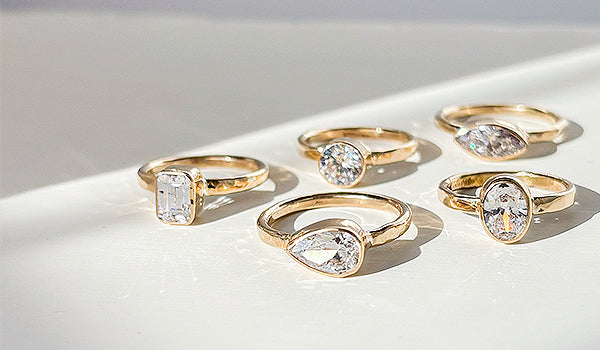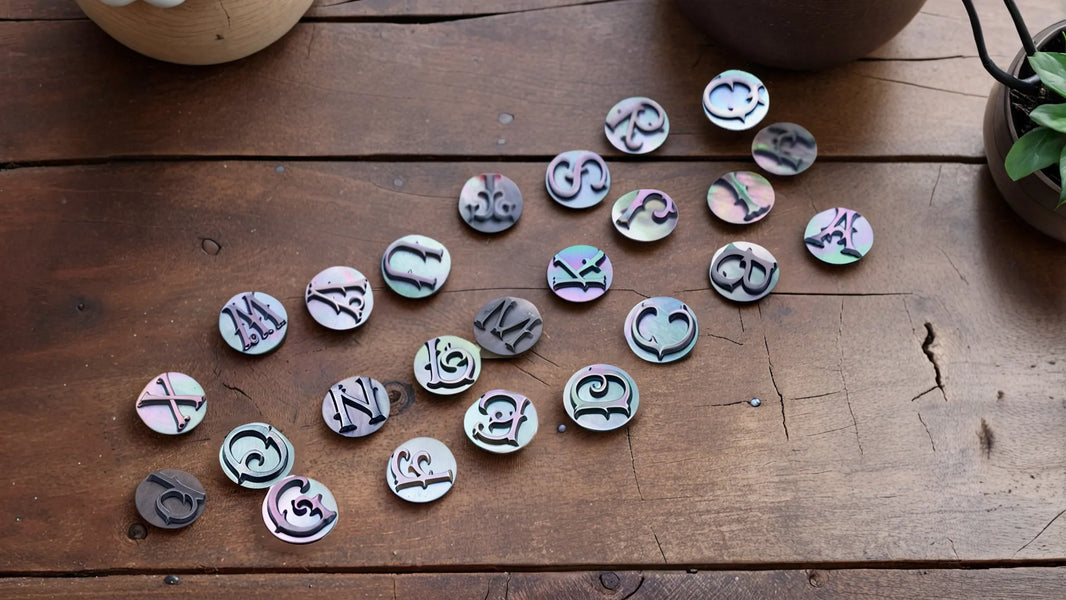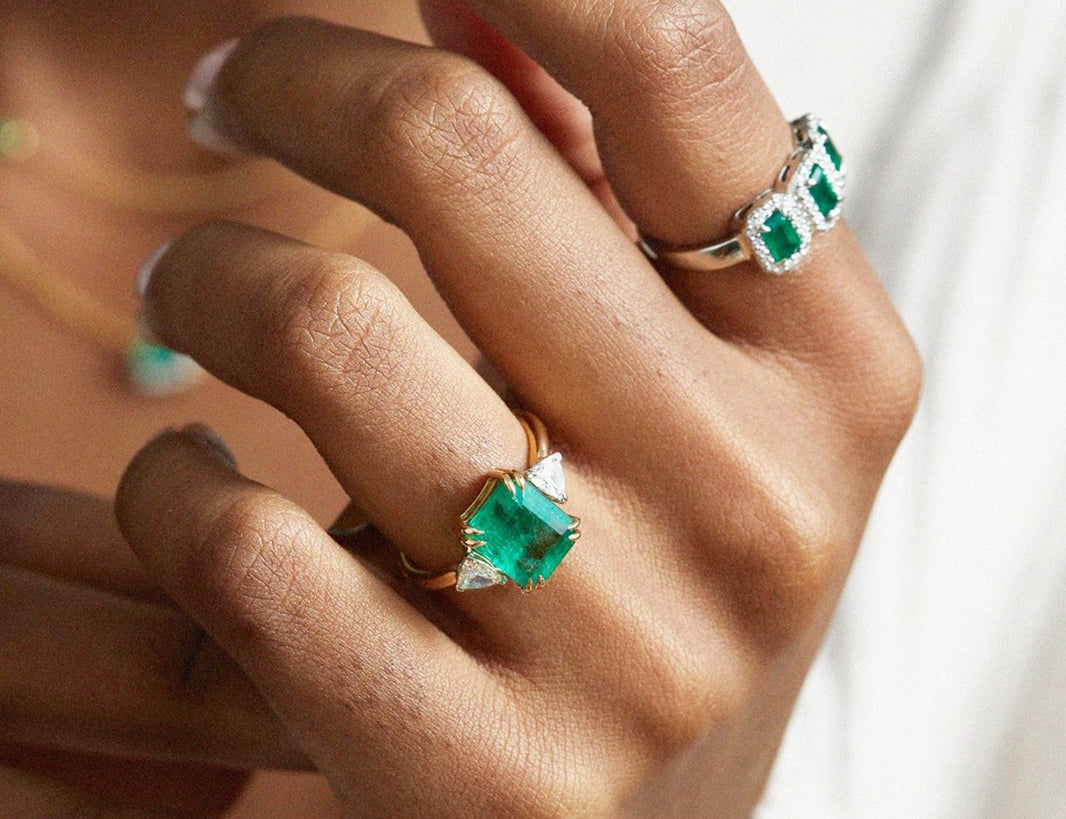Blue sapphires have always had a way of quieting a room. The first time I slipped a lab-grown blue sapphire solitaire onto my finger in a showroom, I watched the stone hold its color from store fluorescents to the soft haze of late-afternoon window light. It was the same serene, regal blue that made me fall in love with vintage pieces—but at a price that made sense for a real life with rent, student loans, and weekend road trips. If you’re craving that noble blue without a noble’s budget, a lab sapphire engagement ring offers a persuasive, modern answer.
What a Lab Sapphire Really Is—and Why It’s Ideal for Everyday
A lab sapphire is sapphire in every gemological sense. It is corundum with the same chemistry, crystal structure, and Mohs hardness of 9 as its mined counterpart. In practical terms, this means excellent scratch resistance for daily wear, second only to diamond. GIA distinguishes durability into three ideas: hardness, or resistance to scratching; toughness, or resistance to chipping and breaking; and stability, or resistance to light, heat, and common chemicals. Sapphires score well across the board for engagement-ring duty, which is why GIA consistently lists ruby and sapphire among the best daily-wear colored gems.
When shoppers ask if lab sapphires are “real,” they’re usually asking if they perform like natural stones on the hand and over time. In my experience setting and wearing lab sapphires in both prong and bezel designs, they shrug off the scuffs of keyboards and countertops while holding color in mixed lighting. That aligns with retail and consumer guides from CustomMade, The Knot, and James Allen, which all position sapphire—lab or natural—as an excellent everyday choice due to Mohs 9 hardness and strong stability.
Blue First: Why This Hue Wins on a Budget
Blue is sapphire’s archetype because it communicates depth, trust, and timeless style. Berlinger Jewelry and The Knot highlight how blue sapphires read as loyal and faithful—traits that suit an engagement ring’s meaning. If you’re cost-sensitive, pay attention to hue and modifiers. CustomMade notes that classic blue ideally skews pure-blue to violet-blue, while stones with a subtle green cast are often discounted even though many couples love their one-of-a-kind character. In hand, that small compromise in purity often buys you a larger face-up look or a better setting; it’s an easy win for budget buyers who value presence over perfection.
Lab vs. Natural: Value, Performance, and Trade-Offs
Here is a concise comparison based on consumer guides and gemology references. Color will always be your most important driver; the rest helps you decide which path best fits your goals.
Factor |
Lab Sapphire |
Natural Sapphire |
Notes and Sources |
Composition and hardness |
Corundum; Mohs 9 |
Corundum; Mohs 9 |
Same species and wear profile; see GIA and James Allen. |
Color range |
Consistent “top” blues and common hues; fewer subtle variations |
Broad range of hues, tones, and saturation including nuanced modifiers |
CustomMade reports labs are standardized; naturals show wider variety. |
Typical 1 ct price |
About 600.00 |
Blue about 3,100.00; white about 700.00; padparadscha about 4,000.00 |
Figures summarized from CustomMade’s buying guide. |
Inclusions |
Often very clean |
Minor inclusions common and acceptable |
GIA notes inclusions can help confirm natural origin in colored gems. |
Treatments |
Usually none beyond growth method |
Heat treatment common and accepted; diffusion less desirable |
GIA advises full disclosure; treatment affects care. |
Origin prestige |
Origin irrelevant |
Certain origins can command premiums |
GIA and The Knot note origin/provenance can raise price. |
Availability above 2 ct |
More predictable supply and price |
Scarcer and more expensive in high quality |
CustomMade highlights easier sourcing of large labs. |
Resale and heirloom value |
Generally lower secondary-market demand |
Typically stronger secondary-market interest for fine stones |
Market observation; verify with a jeweler or appraiser. |
How Much Should You Budget?
A realistic plan begins with the center stone, then adds the setting and any accent stones. The center stone is where lab sapphires shine on price predictability. CustomMade cites approximately 600.00 for a well-colored 1 ct lab sapphire. Add a durable 14K setting and modest diamond accents, and many couples land comfortably between $1,100.00 and $2,000.00 for a finished ring that looks luxurious. If you favor platinum, intricate pavé, or a designer atelier, expect higher totals.
One overlooked factor that quietly improves budgets is density. Sapphires are denser than diamonds, so a 1 ct sapphire faces up smaller than a 1 ct diamond. If you want maximum finger coverage, opt for elongated shapes like oval or pear, or use a slim halo that increases diameter with small, affordable stones. This face-up strategy is widely recommended in consumer guides and echoed by CustomMade’s commentary on shape and size dynamics.
To make planning concrete, here is a quick, indicative snapshot of how budgets often come together. These are not quotes; they simply show likely proportions given typical retail patterns.
Goal |
Center Stone |
Setting Choice |
Approximate Ring Total |
Comments |
Entry-level blue brilliance |
Lab sapphire about 1.0 ct |
14K solitaire |
1,300.00 |
Clean, timeless look; spend on polish and prong quality. |
Bigger look for less |
Lab sapphire about 0.9–1.1 ct |
14K halo with petite accents |
2,000.00 |
Halo magnifies size affordably; check accent quality and secure seats. |
Premium metal, daily wear |
Lab sapphire about 1.0 ct |
Platinum bezel |
2,600.00 |
Bezel protects edges; platinum resists wear; higher labor and metal cost. |

Color, Cut, and Setting Choices That Stretch Your Dollars
Color drives value most. Aim for an even, lively blue—neither inky nor washed—because mid-range tones with strong saturation look vivid under the mixed lighting of offices, restaurants, and home. CustomMade emphasizes that lab sapphires deliver consistent “top” color, but if you enjoy character, you may love a natural blue with a whisper of green, often at a friendlier price.
Cut should serve color, not just sparkle. Sapphires are frequently cut in ovals, cushions, and rounds to balance brilliance and body color. A cushion with slightly deeper pavilions can saturate blue pleasantly; an oval can spread face-up for more presence on the finger. Avoid windowing, where light leaks through the center and the stone looks see-through; this is a cut-proportion issue your jeweler should flag.
Settings are your most powerful optical lever. Halos amplify spread and brightness, bezels protect edges and create a sleek profile for active lifestyles, and prong solitaires offer the most light entry for crisp scintillation. GIA recommends protective settings when you choose more delicate gem types; sapphire does not need coddling, yet a low-profile or bezel design still earns its keep if you rock climb, weightlift, or tinker with tools.

Metal Matters: How Mounting Color Shapes Blue
Metal color subtly reframes sapphire. White gold and platinum intensify cool, crisp blues and modern silhouettes, while yellow gold adds warmth and a slight vintage glow. Capucinne and The Knot both note that metal choice is a design tool as much as a materials choice. If your sapphire has slight violet in its blue, white metals tend to keep the look bold and clear. If your stone leans a hair green, yellow gold can look intentionally antique, almost painterly.
Blue Tone |
Best-Match Metals |
Design Effect |
Pure to violet-blue |
Platinum, 14K/18K white gold |
Clean contrast, high brightness, contemporary lines |
Slight green-blue |
14K/18K yellow gold |
Warm balance, vintage charm, softens the green hint |
Pastel to medium blue |
Rose gold, yellow gold, slender halos |
Romantic hues, enhanced presence without darkening |

Care and Cleaning: Simple, Safe, and Sustainable
Sapphire care is refreshingly straightforward. GIA recommends warm, soapy water with a soft brush for most colored stones, and that is the routine I use at home for both lab and natural sapphires. Ultrasonic or steam cleaning can be safe for sapphires that are not fracture-filled and do not have significant inclusions, but caution is wise if you do not know the stone’s treatment history. When in doubt, stick to soapy water and a lint-free cloth, and schedule an annual prong and setting check with your jeweler to keep the stone secure.
There is a small disagreement in the consumer space about whether ultrasonic cleaning is “generally okay” for sapphires. Some retailer guides note it is often fine for heat-only stones, while GIA adds a caveat about inclusions and treatments. The difference likely comes from methodology and risk tolerance: a lab guide assumes clean, heat-only stones, while a broad gemology source accounts for edge cases. The practical path for budget buyers is simple and safe cleaning at home and professional maintenance when needed.
Certifications, Transparency, and the Fine Print
Documentation protects your budget. For natural sapphires, a report from GIA or AGL helps confirm identity and treatments, and sometimes origin. Even for lab sapphires, a clear invoice that states “lab-grown sapphire,” metal purity, and any accent-stone details is essential for insurance and future service.
If a listing looks too good to be true, lean into skepticism. One archive product card for an 18K white gold sapphire ring discounted to $54.99 urged checking hallmark, origin, treatment disclosure, warranty, and return policy—sensible advice. A genuine 18K setting alone usually costs more than that, so treat extraordinary pricing as a prompt to verify whether the piece is plated, the sapphire is synthetic corundum of unknown growth, a simulant like glass, or the carat weights are misprinted. Ask for a quick video under neutral light and a copy of any lab or internal appraisal; a reputable seller will not hesitate.
Pros and Cons of Choosing Lab Sapphire
The strongest benefits are price transparency, durability, and the ability to buy beautiful color at sensible sizes. You can allocate more of the budget to craftsmanship: tighter prongs, a better-cut halo, and clean, balanced proportions that show in photos and in person. Lab sapphires also offer predictable supply in the 1–2 ct range, which is helpful if you are trying to time a proposal between Thanksgiving and New Year’s.
The trade-offs are largely about romance and collecting. Natural sapphires carry stories of origin and, occasionally, provenance that command premiums. Some connoisseurs enjoy the nuanced “personality” of natural color that labs often standardize. Secondary-market value for lab sapphires is generally weak because replacement cost remains low. If resale matters to you, discuss it candidly with a local jeweler and your insurer.
A Note on “Peach” vs. Padparadscha Pricing
Budget shoppers encounter conflicting claims about peach sapphires. Fine Color Jewels describes peach sapphires as affordable alternatives, while CustomMade lists padparadscha—the historic pink-orange variety—as among the pricier colors for 1 ct stones. The disagreement likely arises from definitions and sampling. Some retailers use “peach” broadly for many pink-orange shades, including lab stones and lower-saturation pieces that are less expensive. Laboratories and conservative dealers reserve “padparadscha” for a narrow, delicate balance of pink and orange that commands premiums. If you are considering peach tones, ask a lab or experienced jeweler whether the stone meets strict padparadscha criteria or is simply a lovely peach sapphire with a friendlier price.

The Best Way to Buy on a Budget, Without Compromising Taste
Begin with color. Request videos of two or three blue lab sapphires in different tones and saturations under daylight and indoor LEDs. Choose the one that looks vivid in both. Next, select a shape that flatters your hand and your budget. Ovals and pears spread beautifully; cushions evoke vintage elegance; rounds feel classic and balanced. Then focus on the setting. If you use a halo, ask for fine, even beadwork and slightly tapering prongs so the center reads crisp. If you prefer a bezel, keep the rim slim and the stone set low for comfort. Finally, decide on metal. White gold or platinum emphasizes classic blue; yellow gold infuses warmth if you love a slightly moodier, storybook look.
Throughout, leverage a jeweler’s expertise, but keep documentation central. Confirm “lab-grown sapphire” in writing, list metal purity, record accent-stone totals, and keep the receipt for insurance. Clean with warm, soapy water and plan an annual checkup. A ring that is thoughtfully built wears better and ages well, which is the real secret to budget luxury.

Overlooked Insights Worth Knowing—Folded Into Your Choice
One insight many guides skip is how lighting in your daily life shapes satisfaction. Office LEDs can gray out overly dark blues, while restaurant and sunset light make medium blues glow. Ask to see stones at the door, by a window, and under desk lamps before you decide; this “three-light test” has saved more than one couple from buyer’s remorse.
Another practical nuance is that standardized “top” lab color can feel almost too perfect for vintage-inspired settings. If you adore the romance of antique styles, a lab sapphire with a whisper of violet or a slightly softer tone can look more period-correct. This is a design judgment, not a quality judgment, and it is easier to see than to describe—request side-by-side videos.
Finally, there is a quiet care discrepancy about ultrasonic cleaning. Some retailer guides say it is usually fine for sapphires, while GIA recommends confirming treatment and inclusion state first. The safest approach for budget rings with small accents is always warm, soapy water at home and professional cleaning when you are already in for a prong check.
Quick Reference Tables to Guide Decisions
Decision |
What To Prioritize |
Why It Helps on a Budget |
Color selection |
Medium to medium-dark vivid blue that stays lively under mixed light |
Looks vivid in real life without paying for inky “collector” tones |
Shape and spread |
Oval or pear for more finger coverage per carat |
Maximizes perceived size without buying bigger carat weights |
Setting choice |
Slim halo or refined bezel |
Halo adds presence; bezel protects edges and keeps profiles wearable |
Metal selection |
White gold/platinum for crisp blue; yellow gold for warmth |
Tunes mood without changing the stone |
Real-World Wear Test: What Blue Lab Sapphire Is Like After a Year
A bezel-set, one-carat lab sapphire in 14K yellow gold has been my weekday ring through client meetings, laptop marathons, and grocery runs since last fall. The stone shows faint sleeve scuffs on the metal but stays crisp and bright after a quick lather with mild dish soap and a soft brush. The bezel saved the day once when it clipped a cabinet edge—no chip, no drama. This is precisely the promise of lab sapphire: everyday elegance without elevated anxiety.

Takeaway
A lab-grown blue sapphire delivers the look, meaning, and daily-wear performance that make sapphire a perennial favorite—at a price that leaves room for craftsmanship. Choose color first, optimize spread with a smart shape and setting, and anchor the purchase with clear documentation. Listen to GIA for care basics, lean on CustomMade’s price benchmarks for planning, and let your own eye be the final authority. Blue beauty on a budget is not a compromise; it is a strategy.
FAQ
Are lab sapphires real gemstones?
Yes. Lab sapphires are corundum with the same chemistry, crystal structure, and Mohs hardness of 9 as mined sapphires. This is why guides from GIA and James Allen treat them as genuine gemstones rather than imitation materials.
Will a lab sapphire hold up to daily wear?
With Mohs 9 hardness and good toughness and stability, sapphire is excellent for everyday rings. GIA emphasizes that warm, soapy water cleaning and periodic prong checks are the safest maintenance routine.
How much should I expect to pay for a 1 ct blue lab sapphire ring?
CustomMade reports about 600.00 for a 1 ct lab sapphire. A well-made 14K setting brings many rings into the 2,000.00 range depending on design, metal, and accents.
Do I need a lab report for a lab sapphire?
For lab-grown stones, an invoice that clearly states “lab-grown sapphire,” the metal purity, and accent details is often sufficient for insurance. For natural sapphires, reports from GIA or AGL are valuable to document identity, treatments, and sometimes origin.
Is ultrasonic cleaning safe for sapphire?
It can be for heat-only stones without significant inclusions, but GIA advises confirming treatment and inclusion state first. When in doubt, use warm, soapy water and a soft brush, and rely on professional cleaning during annual setting inspections.
What is the difference between peach sapphire and padparadscha?
“Peach” is a broad retail color description for pink-orange hues; “padparadscha” is a stricter, lab-recognized balance of pink and orange that often commands higher prices. CustomMade lists padparadscha among pricier colors, while some retailers market peach tones as budget-friendly. The discrepancy likely reflects differences in definitions and stone selection.

References
- https://4cs.gia.edu/en-us/blog/colored-gemstone-engagement-rings-buying-guide/
- https://repository.tilburguniversity.edu/bitstreams/1fbf51d0-d8dc-4199-8334-030b7a12698a/download
- https://production.cbts.edu/fetch.php/48nF9E/897090/Diamond_Clarity_And_Color_Chart.pdf
- https://admisiones.unicah.edu/Resources/B6zsS5/5OK098/dark__history-of__engagement__rings.pdf
- https://www.uc.edu/content/dam/refresh/cont-ed-62/olli/olli_docs/jewelry.pdf
- http://faculty.washington.edu/sandeep/old/teaching/conmkt/phasei~1.htm
- https://alt.wiche.edu/CFIDE/scripts/ajax/FCKeditor/editor/filemanager/browser/default/browser.html?vid=1323423711&&Connector=%2F%5C%2Fblog%2Ez00x%2Eorg%2FP%2F
- https://www.angara.com/c/sapphire-engagement-rings?srsltid=AfmBOorq4coe6Gml8j2XXEZ2Bjgt3MGGYCQq16HJeo1P4edI1DOOvULQ
- https://capucinne.com/collections/sapphire-rings?srsltid=AfmBOorxCNfv8YYDUKrVBSTqhk3QrrIYJhN-EuJk8tizu4pSHyfHImjo
- https://www.diamondsfactory.com/engagement-rings/sapphire-engagement-rings









